Building used by Kays throughout the United Kingdom
Worcester
These are some of the buildings used by Kays in Worcester city. Both exterior and interior views are included.
St Swithins Steet
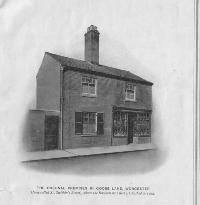
The original clock and watchmakers shop was in 1794 (or earlier) John Skarratt started to trade in Worcester. Known as St Swithin’s Street today, it was originally known as Goose Lane. The shop lasted Skarratt for about twenty years when he decided to move the business to Broad Street. In recent years, the shop was used by “Blooms”, a local florist, until they moved out in 2009. The building has now (2011) been divided into two smaller shops.
In 1994, Kays placed a commemorative bronze plaque on the outside wall of the building to celebrate the 200th anniversary of the business.
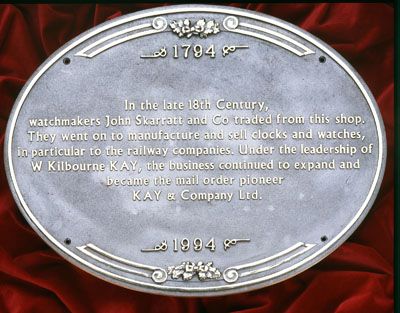
This plaque was put onto the wall of the St Swithin’s Street shop (shown above) in 1994 to commemorate the 200th anniversary of Kays. Research has shown that the details given in the third sentence are historically inaccurate as Kays bought Skarratt’s in 1896.
Broad Street
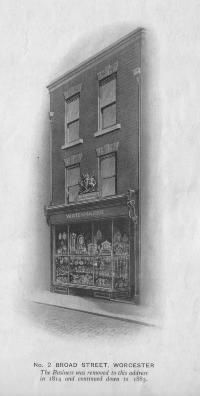
In 1814, Skarratt moved his business to Number 2 Broad Street where it remained for the next ninety years. Although the picture shows a two window frontage, this was expanded sometime later (believed to be in the mid 1850s) by the addition of another floor and an additional “wing”. The premises were renumbered to Number 3, Broad Street. The shop still exists today and “ShoeZone” operate their business from these premises. William Kilbourne Kay lived “above the shop” at Number 3, Broad Street and is recorded as doing so on the birth certificates of his first born son, Tom and his second son, Edwin. The Kay family lived here until 1886.
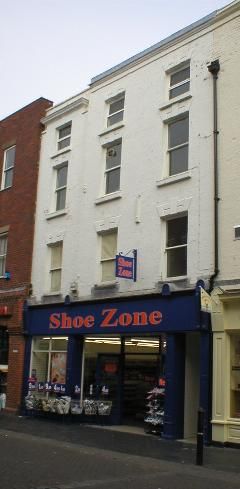
The shop in Broad Street as it is in the 21st century. The extensions to the original building can clearly be seen when compared to the view shown above. This is how William Kay would have seen the building when he arrived for work each day in the 1870s. The newly married Mr & Mrs Kay were living in the rooms behind the windows at the top of the building. These are now store rooms.
Foregate
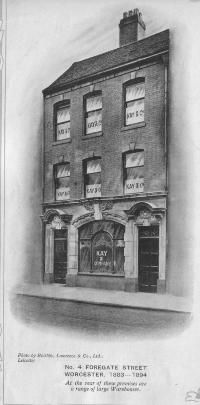
This is number 4, The Foregate in Worcester. Originally used by “Kay, Jones & Co”, jewellers and watchmakers, the first business enterprise of W K Kay and his business partner, George Jones, a local architect. They started in business together in 1886 and watches from this period exist in the Heritage Collection. The partners must have gone their separate ways, for by 1890, the premises of “Kays of Worcester” are operating from this building. William Kilbourne Kay started his own enterprise, his “Universal Stores”, with an errand boy, some clerical and warehouse staff but within five years he was employing over fifty staff. Today the building is used by “Humberts”, the local estate agents.
Shrub Hill Road
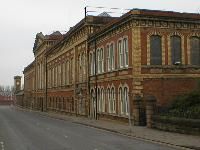
Shrub Hill Road, Worcester was the home of Kays from 1894 until 1908. Known, to many in recent times, as “Heenan & Froude’s” (a local engineering company, who built Blackpool Tower, amongst other things), the building was originally built for a railway carriage works in the 1850s and was the venue for “the Great Commercial Exhibition” of 1882. Not far from Shrub Hill railway station, Kays had easy access to the railways for deliveries of its goods.
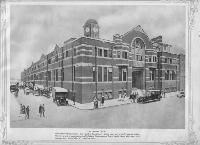
This is the building that William Kilbourne Kay had built specifically to house the company’s operations from 1908 onwards. Built to his specification, it was constructed between 1907 and 1908 and was considered to be a very modern building as it had central heating, electric lifts and its own telephone system. It cost over £16,800 to build. Known simply as St. Oswalds to all of the staff who have worked in the company during the 20th century, it was vacated in May 2002, when the company moved to new premises adjacent to the newly-built hospital complex at Newtown Road, Worcester. St Oswald’s has now been bought by a local property developer and has been converted into luxury apartments and offices.

This is the office that was the heart of the Kays organisation in the 1920s. You can see W Kilbourne Kay at work dealing with correspondence and his secretary taking shorthand. The office is on the very corner of the St Oswald’s building on the ground floor (see above). The telephone system enabled Kay to reach all parts of his organisation without leaving his desk.
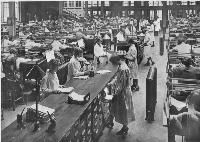
This is a view of the main office in August 1920. All of the customer (agent) accounts were administered from here and the filing and ledger clerks were key to ensuring that records were kept accurately for every one of Kays’ agents. Staff were fined if they made an error on an agent’s account and all calculations were done without calculators!
9 – 10 The Tything

The frontage of number 9-10 The Tything. This is the only part of the original building, completed in 1938, that remained after the fire of 1941. Used for many years as the Agency Office and Call Centre the office was closed in 2002. The building is being converted into apartments and commercial offices.
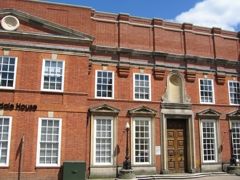
This view of the Tything building shows how the building has been restored to as it was when first opened in 1939 and before the fire. The redevelopment of the site into offices and residential property has seen the windows added to the first floor and the balustrade added above the roof line. The look and feel of this impressive frontage as it was originally built has been maintained.
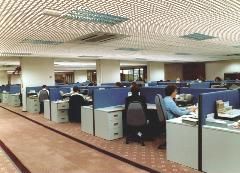
The Kays’ call centre, located in the Tything offices, was one of the many call centres located around the U.K. that took calls from customers and agents. This view was taken in the early 1990s and shows the operators at work in well-designed and modern office accommodation. The plum coloured carpet on the floor was especially made for the offices and cost several hundred thousands of pounds. It was last seen being bulldozed up into the top right hand corner of this view, when these offices were demolished in 2004. The Clydesdale Bank now have a similar operation on the site, in new offices that were built in 2004-2005.
250 Bransford Road
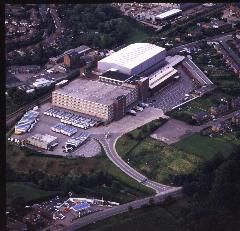
This is a view of the company’s main warehouse located in the south-west of Worcester. Known as “Pierau” (after the German designer), “Bromyard Road” or more recently as “250 Bransford Road”, the building was constructed in the late 1960s, and is a major distribution centre for the company’s parcels. The site was originally occupied by Alley and MacLellan, an engineering company that made valves and springs.
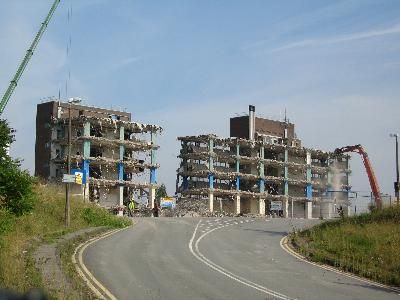
The final days of demolition of the 250 Bransford Road site seen in August 2010. BY the end of the year the site was levelled and the debris was being removed.

The demolition of 250 Bransford Road was started in September 2008. This is the view from the gate at the Bromyard Road entrance. Midland Office, the Staff Shop and Bay 1 have been reduced to rubble. The carton store is in the process of being demolished.
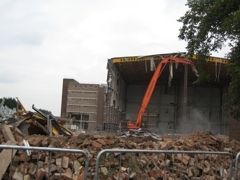
A closer view of the Carton Store being demolished in early October 2008. By the end of the month the structure had been raized to the ground. The rubble in the foreground was once the home of the Marketing team – Midland Office.
Northwick Avenue, Barbourne
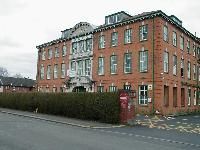
This impressive building is the Barbourne Warehouse located in Northwick Avenue to the north side of Worcester. Acquired in the early 1950s, the building was originally built for a printing company in the 1890s. Barbourne was used as a despatch warehouse until the larger warehouse at Bransford Road was built in 1967. Closed in 1971 and then re-opened in 1975 the building was used until 2002 as offices and warehouses. Like the other two office buildings in the Tything, it has now been converted to residential apartments.
Pierpoint Street, Worcester, the Photographic Studio

This impressive building, located near the centre of Worcester in Pierpoint Street, was used by Kays as its main photographic studio from 1968 until the Studio moved to a new site in 1992. Prior to being used as the Studio the company used the building as offices. Many of the photographs used in the Kays’ catalogues were taken in these studios by the company’s own photographers. There were also fully equipped studios and processing labs here.
Kidderminster
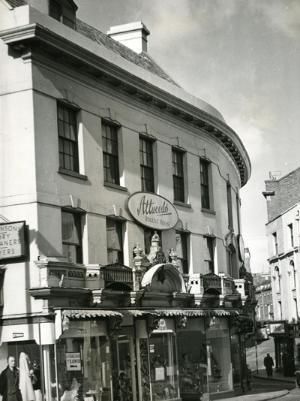
In the 1950s, Kays bought a department store in the town of Kidderminster. A number of office-based functions concerned with customer accounts were moved there from Worcester. Little is known of what went on at Attwoods but the group would like to hear from anyone who can provide more details of the operations or more images of the store.
Leeds, West Yorkshire
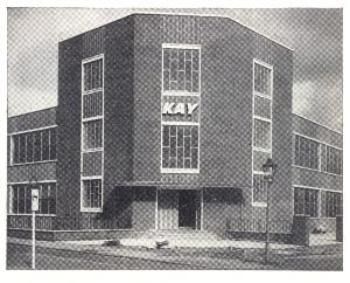
This impressive frontage at Marshall Street was completed in 1958. Kays amalgamated Samuel Driver Ltd into their operations in 1956 and the company inherited the Driver’s site at Marshall Street, Leeds and then started a rebuilding programme. New offices were built, as can be seen to the left and right of the entrance, in this view taken from the internal Kays staff newspaper, Kays Link.
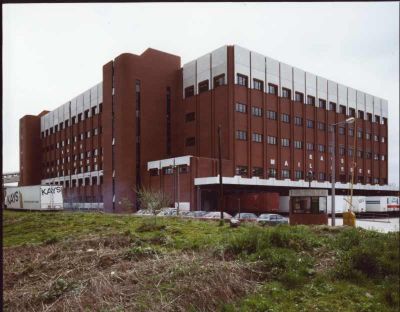
The Sweet Street warehouse was completed in 1981 and was the last major building project undertaken by the company. About 3/4 of the size of the Worcester warehouse, the “northern” customers were sent their orders from this warehouse. It closed in August 2004.
In 2008 work started to demolish the building and by 2009 it had been removed entirely from the skyline of Leeds. (Any photographs of the demolition would be welcomed by the group).
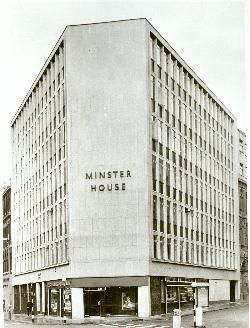
The offices in the south-west of England were located in Baldwin Street, Bristol. Several floors of this city-centre building were occupied by Kays and the tri-angular nature of the floors caused some interesting office layouts. In the late 1970s the company moved to offices at Staple Hill in Bristol.
Glasgow
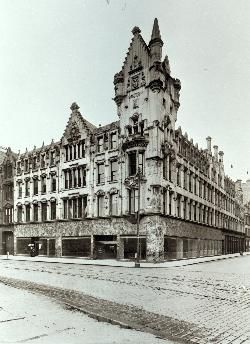
This gothic building was rented from an associate GUS furniture company that occupied the ground floor. Although the address was Albion Street, the Trongate is the road that is in the foreground of this image. Occupied by Kays in the late 1950s, the Albion Street offices remained open until the 1980s when the company moved to rented accommodation in George Square. The office operations at Glasgow were closed in the mid 1990s and the work transferred to Leeds.
Newtown, Powys
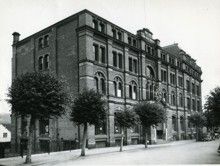
This is the “Royal Welsh Warehouse” in Newtown, Powys. The original offices and warehouses of Pryce Jones Ltd were patronised by Queen Victoria while on her way to holiday on the coast at Aberystwyth. Bought and sold by Kays three times during the 20th century, the offices of Pryce Jones became the main offices for Welsh agents and remain a part of the company operations today. The company continued to issue the “Royal Welsh Warehouse” catalogue well into the 1990s.
The use of this historic site came to an end in August 2011 when Littlewood Group closed down their operations at Newtown ending a link in the town with the mail-order business within the UK of over 150 years.
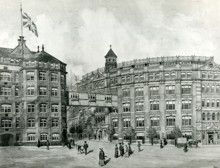
This is a view of the Pryce Jones offices and warehouses in the early 20th century.
York
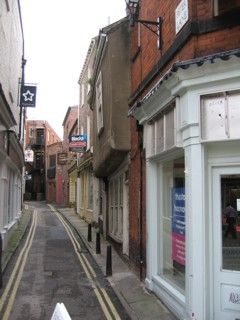
This is a view of the Pryce Jones offices and warehouses in the early 20th century. This is Peter Lane, York, taken in October 2006. Kays had an office in this part of the city of York until the late 1980s when the office was closed and the work transferred to Leeds. Memories of visiting this office would give it to have been in the building at the far end of this view but a correction to this would be welcome. No trace of the fact that Kays once had an office here could be traced on the buildings, so any images of Kays in York that might be in the personal albums of past members of staff would be very welcome.
